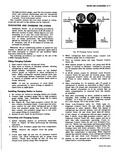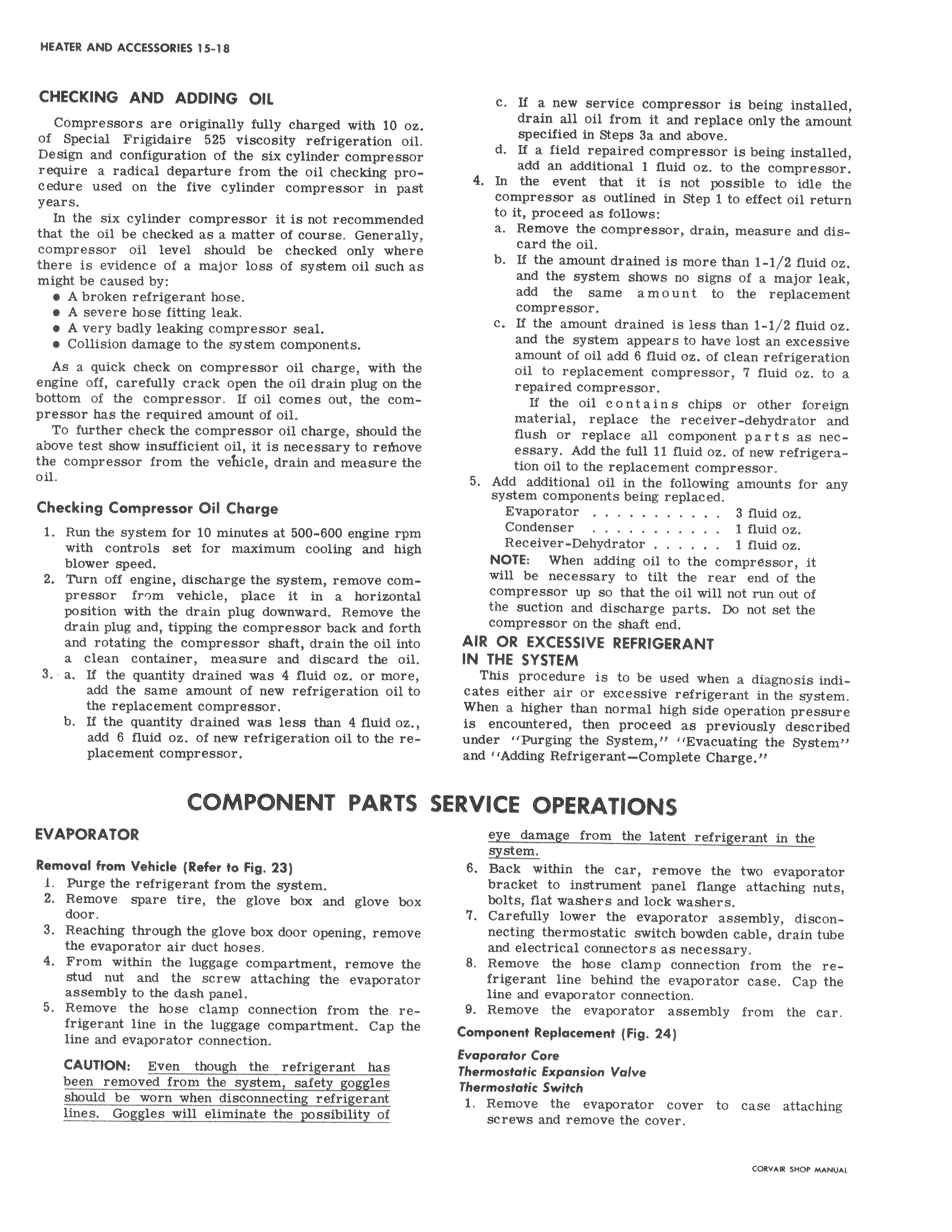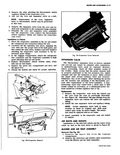Jeep Parts Wiki | Ford Parts Wiki
Home | Search | Browse
|
Corvair Chassis Shop Manual December 1964 |
|
Prev

 Next
Next
CHECKING AND ADDING OIL Compressors are originally fully charged with 10 oz of Special Frigidaire 525 viscosity refrigeration oil Design and configuration of the six cylinder compressor require a radical departure from the oil checking pro cedure used on the five cylinder compressor in pa years In the six cylinder compressor it is not recommended that the oil be checked as a matter of course Generally compressor oil level should be checked only where there is evidence of a major loss of system oil such a might be caused by e A broken refrigerant hose e A severe hose fitting leak e A very badly leaking compressor seal e Collision damage to the system components As a quick check on compressor oil charge with thel engine off carefully crack open the oil drain plug on the bottom of the compressor If oil comes out the com pressor has the required amount of oil To further check the compressor oil charge should the above test show insufficient oil it is necessary to reihove the compressor from the vehicle drain and measure the l oil Checking Compressor Oil Charge 1 Run the system for 10 minutes at 500 800 engine rpm with controls set for maximum cooling and high blower speed 2 Turn off engine discharge the system remove compressor from vehicle place it in a horizontal position with the drain plug downward Remove th drain plug and tipping the compressor back and fortk and rotating the compressor shaft drain the oil into a clean container measure and discard the oil 3 a If the quantity drained was 4 fluid oz or more add the same amount of new refrigeration oil to the replacement compressor b If the quantity drained was less than 4 fluid oz add 6 fluid oz of new refrigeration oil to the replacement compressor i COMPONENT PARTS SE EVAPORATOR Removal from Vehicle Refer to Fig 23 1 Purge the refrigerant from the system 2 Remove spare tire the glove box and glove box door 3 Reaching through the glove box door opening remov the evaporator air duct hoses 4 From within the luggage compartment remove the stud nut and the screw attaching the evaporatox assembly to the dash panel 5 Remove the hose clamp connection from the re i frigerant line in the luggage compartment Cap the line and evaporator connection CAUTION Even though the refrigerant has been removed from the system safety goggles should be worn when disconnecting refrigerant lines Goggles will eliminate the possibility of c If a new service compressor is being installed drain all oil from it and replace only the amount specified in Steps 3a and above d If a field repaired compressor is being installed add an additional 1 fluid oz to the compressor 4 In the event that it is not possible to idle the compressor as outlined in Step 1 to effect oil return to it proceed as follows a Remove the compressor drain measure and disCard the oil b If the amount drained is more than 1 1 2 fluid oz and the system shows no signs of a major leak add the same amount to the replacement compressor c 1f the amount drained is less than 1 i 2 fluid oz and the system appears to have lost an excessive amount of oil add 6 fluid oz of clean refrigeration oil to replacement compressor 7 fluid oz to a repaired compressor If the oil contains chips or other foreign inaterial replace the receiver dehydrator and flush or replace all component parts as necessary Add the full 11 fluid oz of new refrigeration oil to the replacement compressor 5 Add additional oil in the following amounts for any system components being replaced Evaporator 3 fluid oz Condenser 1 fluid oz Receiver Dehydrator 1 fluid oz NOTE When adding oil to the compressor it will be necessary to tilt the rear end of the compressor up so that the oil will not run out of the suction and discharge parts Do not set the compressor on the shaft end AIR OR EXCESSIVE REFRIGERANT IN THE i SYSTEM This procedure is to be used when a diagnosis indicates either air or excessive refrigerant in the system When a higher than normal high side operation pressure is encountered then proceed as previously described under Purging the System Evacuating the System and Adding Refrigerant Complete Charge RVICE OPERATIONS eye jdamage from the latent refrigerant in the 6 Back within the car remove the two evaporator bracket to instrument panel flange attaching nuts bolts flat washers and lock washers 7 Carefully lower the evaporator assembly disconnecting thermostatic switch bowden cable drain tube and electrical connectors as necessary 8 Remove the hose clamp connection from the refrigerant line behind the evaporator case Cap the line and evaporator connection 9 Remove the evaporator assembly from the car Component Replacement Fig 44 Evaporator Core Thermostatic Expansion Valve Thermostatic Switch 1 Rembve the evaporator cover to case attaching screws and remove the cover

 Next
Next